MITSUBISHI OUTLANDER 2015 3.G Repair Manual
Manufacturer: MITSUBISHI, Model Year: 2015, Model line: OUTLANDER, Model: MITSUBISHI OUTLANDER 2015 3.GPages: 446, PDF Size: 59.52 MB
Page 61 of 446
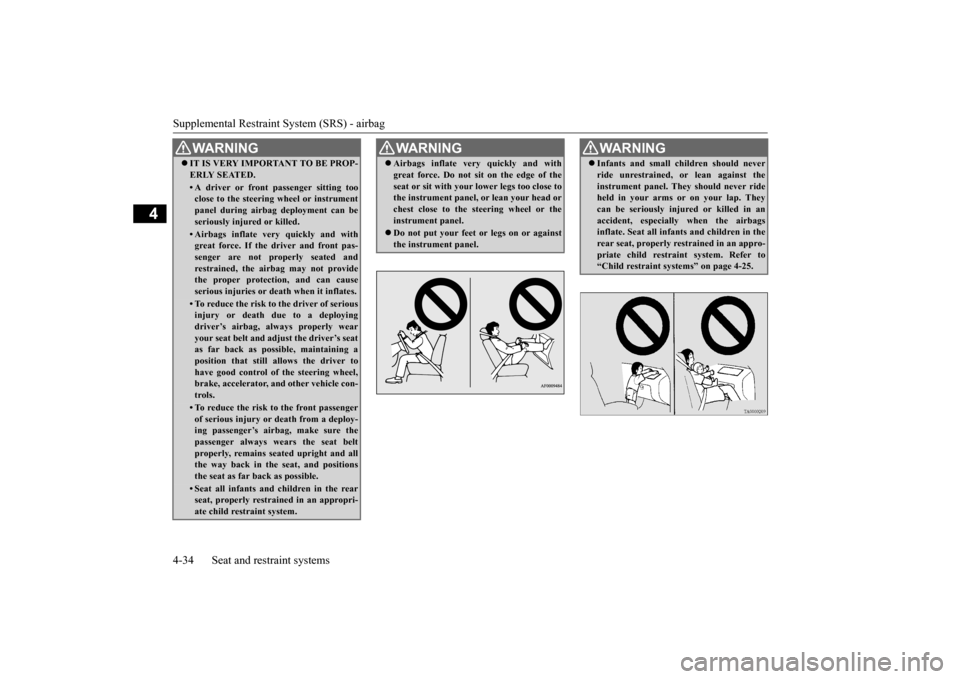
Supplemental Restraint System (SRS) - airbag 4-34 Seat and restraint systems
4
WA R N I N G IT IS VERY IMPORTANT TO BE PROP- ERLY SEATED.• A driver or front passenger sitting too close to the steering wheel or instrument panel during airbag deployment can beseriously injured or killed.• Airbags inflate very quickly and withgreat force. If the driver and front pas- senger are not properly seated and restrained, the airbag may not providethe proper protection, and can cause serious injuries or death when it inflates.• To reduce the risk to the driver of seriousinjury or death due to a deploying driver’s airbag, al
ways properly wear
your seat belt and adjust the driver’s seat as far back as possible, maintaining a position that still allows the driver tohave good control of the steering wheel, brake, accelerator,
and other vehicle con-
trols.• To reduce the risk to the front passengerof serious injury or
death from a deploy-
ing passenger’s airbag, make sure the passenger always wears the seat belt properly, remains seat
ed upright and all
the way back in the
seat, and positions
the seat as far back as possible.• Seat all infants and children in the rearseat, properly restrain
ed in an appropri-
ate child restraint system.
WA R N I N G Airbags inflate very
quickly and with
great force. Do not sit on the edge of theseat or sit with your
lower legs too close to
the instrument panel, or lean your head or chest close to the steering wheel or the instrument panel. Do not put your feet or
legs on or against
the instrument panel.
WA R N I N G Infants and small children should never ride unrestrained, or lean against theinstrument panel. They should never rideheld in your arms or
on your lap. They
can be seriously inju
red or killed in an
accident, especially when the airbagsinflate. Seat all infa
nts and children in the
rear seat, properly re
strained in an appro-
priate child restraint system. Refer to“Child restraint systems” on page 4-25.
BK0211800US.book 34 ページ 2014年3月12日 水曜日 午後2時42分
Page 62 of 446
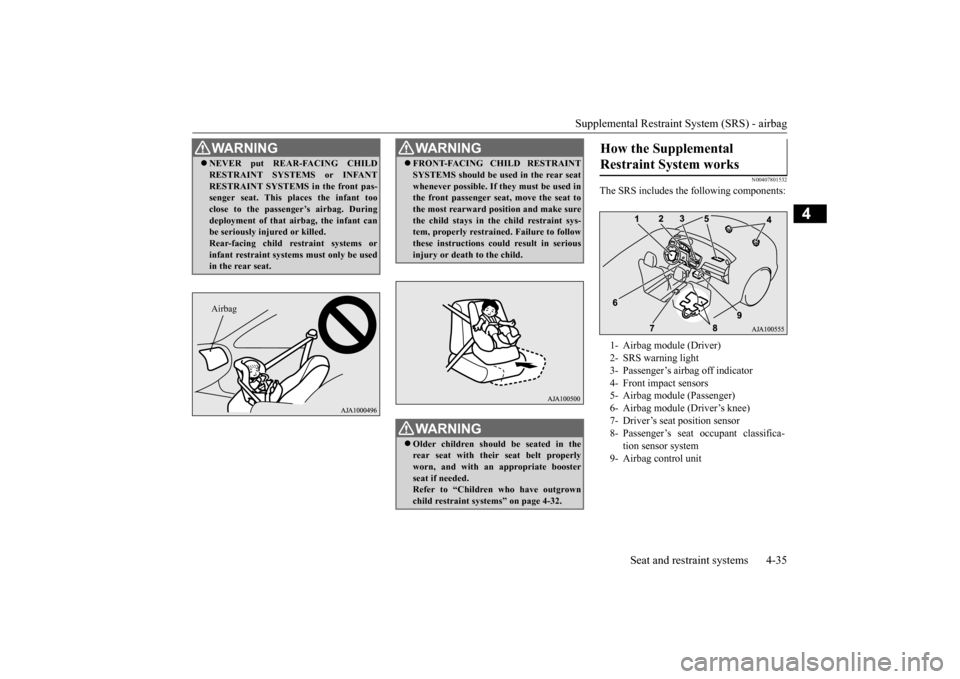
Supplemental Restraint System (SRS) - airbag
Seat and restraint systems 4-35
4
N00407801532
The SRS includes the following components:
WA R N I N G NEVER put REAR-FACING CHILD RESTRAINT SYSTEMS or INFANTRESTRAINT SYSTEMS in the front pas-senger seat. This pl
aces the infant too
close to the passenger’s airbag. During deployment of that airbag, the infant canbe seriously inju
red or killed.
Rear-facing child restraint systems or infant restraint systems must only be usedin the rear seat.Airbag
WA R N I N G FRONT-FACING CHILD RESTRAINT SYSTEMS should be used in the rear seatwhenever possible. If they must be used inthe front passenger seat, move the seat to the most rearward po
sition and make sure
the child stays in the child restraint sys-tem, properly restrained. Failure to follow these instructions could result in serious injury or death to the child.WA R N I N G Older children should be seated in the rear seat with thei
r seat belt properly
worn, and with an
appropriate booster
seat if needed. Refer to “Children
who have outgrown
child restraint systems” on page 4-32.
How the Supplemental Restraint System works 1- Airbag module (Driver) 2- SRS warning light 3- Passenger’s airb
ag off indicator
4- Front impact sensors5- Airbag module (Passenger) 6- Airbag module (Driver’s knee) 7- Driver’s seat
position sensor
8- Passenger’s seat oc
cupant classifica-
tion sensor system
9- Airbag control unit
BK0211800US.book 35 ページ 2014年3月12日 水曜日 午後2時42分
Page 63 of 446
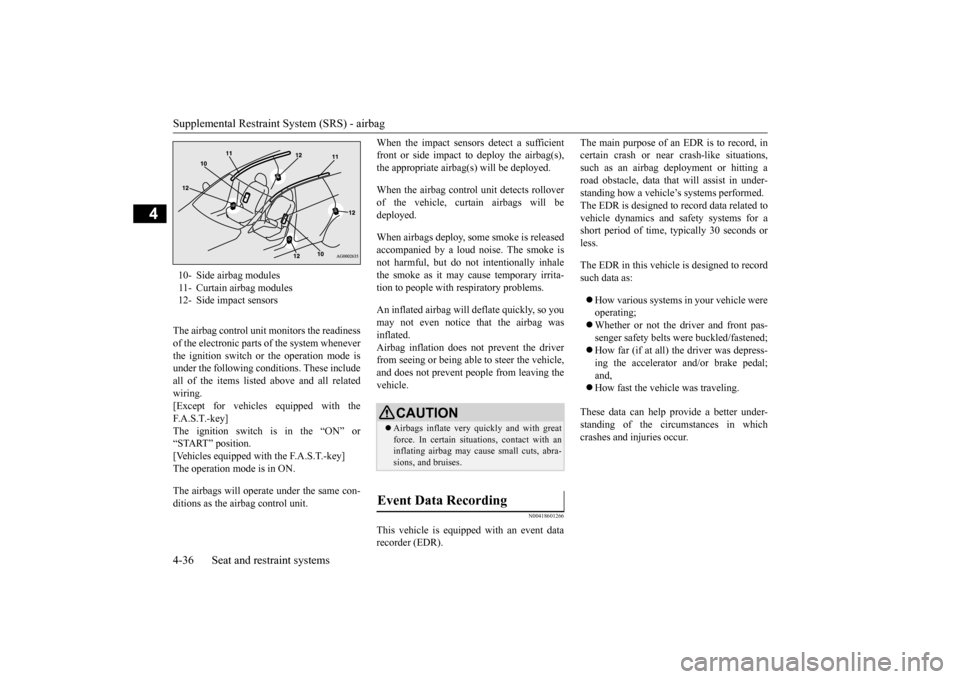
Supplemental Restraint System (SRS) - airbag 4-36 Seat and restraint systems
4
The airbag control unit monitors the readiness of the electronic parts of the system whenever the ignition switch or the operation mode is under the following condi
tions. These include
all of the item
s listed above a
nd all related
wiring.[Except for vehicles equipped with the F. A . S . T. - k e y ] The ignition switch is in the “ON” or“START” position. [Vehicles equipped with the F.A.S.T.-key] The operation mode is in ON. The airbags will operate under the same con- ditions as the airbag control unit.
When the impact sensors detect a sufficient front or side impact to
deploy the airbag(s),
the appropriate airbag
(s) will be deployed.
When the airbag control unit detects rollover of the vehicle, curtain airbags will be deployed. When airbags deploy, some smoke is released accompanied by a loud noise. The smoke is not harmful, but do not
intentionally inhale
the smoke as it may ca
use temporary irrita-
tion to people with respiratory problems. An inflated airbag will deflate quickly, so you may not even notice that the airbag wasinflated. Airbag inflation does not prevent the driver from seeing or being able
to steer the vehicle,
and does not prevent people from leaving the vehicle.
N00418601266
This vehicle is equipped with an event data recorder (EDR).
The main purpose of an EDR is to record, in certain crash or near crash-like situations,such as an airbag deployment or hitting a road obstacle, data that
will assist in under-
standing how a vehicle’
s systems performed.
The EDR is designed to
record data related to
vehicle dynamics and safety systems for a short period of time,
typically 30 seconds or
less. The EDR in this vehicle is designed to record such data as: How various systems in your vehicle were operating; Whether or not the driver and front pas- senger safety belts
were buckled/fastened;
How far (if at all) the driver was depress- ing the accelerator and/or brake pedal; and, How fast the vehicle was traveling.
These data can help provide a better under- standing of the circumstances in which crashes and injuries occur.
10- Side airbag modules 11- Curtain airbag modules12- Side impact sensors
CAUTION Airbags inflate very quickly and with great force. In certain situ
ations, contact with an
inflating airbag may cause small cuts, abra- sions, and bruises.
Event Data Recording
BK0211800US.book 36 ページ 2014年3月12日 水曜日 午後2時42分
Page 64 of 446
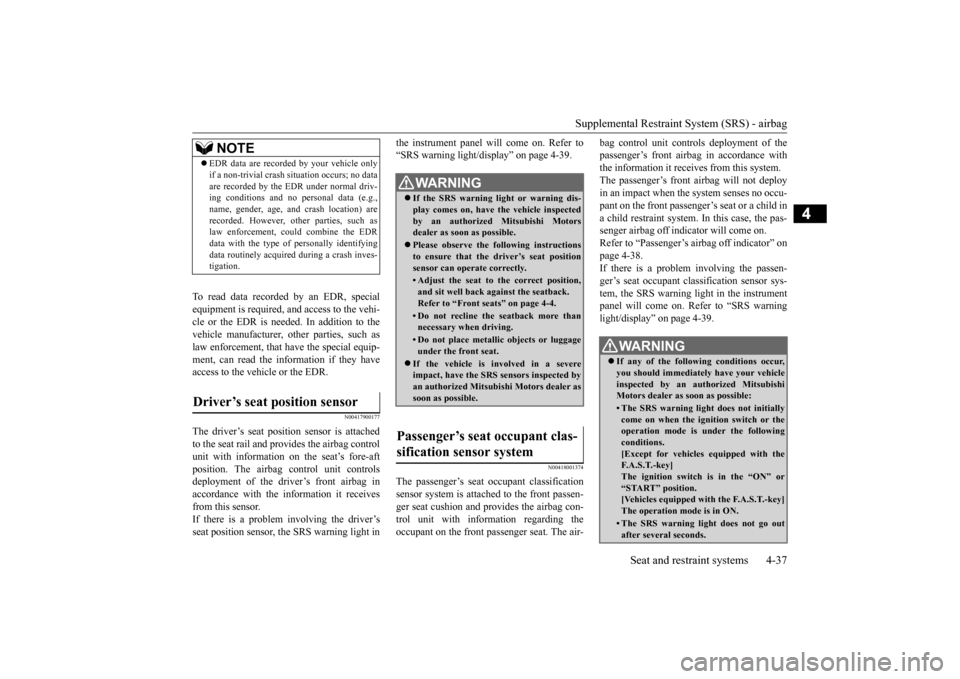
Supplemental Restraint System (SRS) - airbag
Seat and restraint systems 4-37
4
To read data recorded
by an EDR, special
equipment is requi
red, and access to the vehi-
cle or the EDR is needed. In addition to thevehicle manufacturer, ot
her parties, such as
law enforcement, that have the special equip- ment, can read the information if they haveaccess to the vehicle or the EDR.
N00417900177
The driver’s seat posit
ion sensor is attached
to the seat rail and pr
ovides the airbag control
unit with information
on the seat’s fore-aft
position. The airbag control unit controlsdeployment of the driver’s front airbag in accordance with the information it receives from this sensor.If there is a problem involving the driver’s seat position sensor, the SRS warning light in
the instrument panel will come on. Refer to “SRS warning light/display” on page 4-39.
N00418001374
The passenger’s seat oc
cupant classification
sensor system is attached to the front passen- ger seat cushion and provides the airbag con-trol unit with inform
ation regarding the
occupant on the front passenger seat. The air-
bag control unit controls deployment of the passenger’s front airbag
in accordance with
the information it receives from this system. The passenger’s front airbag will not deploy in an impact when the system senses no occu-pant on the front passenge
r’s seat or a child in
a child restraint system. In this case, the pas- senger airbag off indi
cator will come on.
Refer to “Passenger’s ai
rbag off indicator” on
page 4-38. If there is a problem involving the passen- ger’s seat occupant cl
assification sensor sys-
tem, the SRS warning light in the instrumentpanel will come on. Re
fer to “SRS warning
light/display” on page 4-39.
NOTE
EDR data are recorded by your vehicle only if a non-trivial crash si
tuation occurs; no data
are recorded by the EDR under normal driv-ing conditions and no
personal data (e.g.,
name, gender, age, a
nd crash location) are
recorded. However, other parties, such aslaw enforcement, could combine the EDR data with the type of personally identifying data routinely acquire
d during a crash inves-
tigation.
Driver’s seat position sensor
WA R N I N G If the SRS warning li
ght or warning dis-
play comes on, have th
e vehicle inspected
by an authorized
Mitsubishi Motors
dealer as soon
as possible.
Please observe the following instructions to ensure that the driver’s seat positionsensor can operate correctly.• Adjust the seat to the correct position,and sit well back
against the seatback.
Refer to “Front seats” on page 4-4.• Do not recline the seatback more thannecessary when driving.• Do not place metall
ic objects or luggage
under the front seat.
If the vehicle is
involved in a severe
impact, have the SRS sensors inspected by an authorized Mitsubi
shi Motors dealer as
soon as possible.
Passenger’s seat occupant clas- sification sensor system
WA R N I N G If any of the following conditions occur, you should immediatel
y have your vehicle
inspected by an authorized Mitsubishi Motors dealer as soon as possible:• The SRS warning light does not initiallycome on when the ignition switch or the operation mode is under the followingconditions. [Except for vehicles equipped with the F. A . S . T. - k e y ]The ignition switch is in the “ON” or “START” position. [Vehicles equipped with the F.A.S.T.-key]The operation mode is in ON.• The SRS warning light does not go outafter several seconds.
BK0211800US.book 37 ページ 2014年3月12日 水曜日 午後2時42分
Page 65 of 446
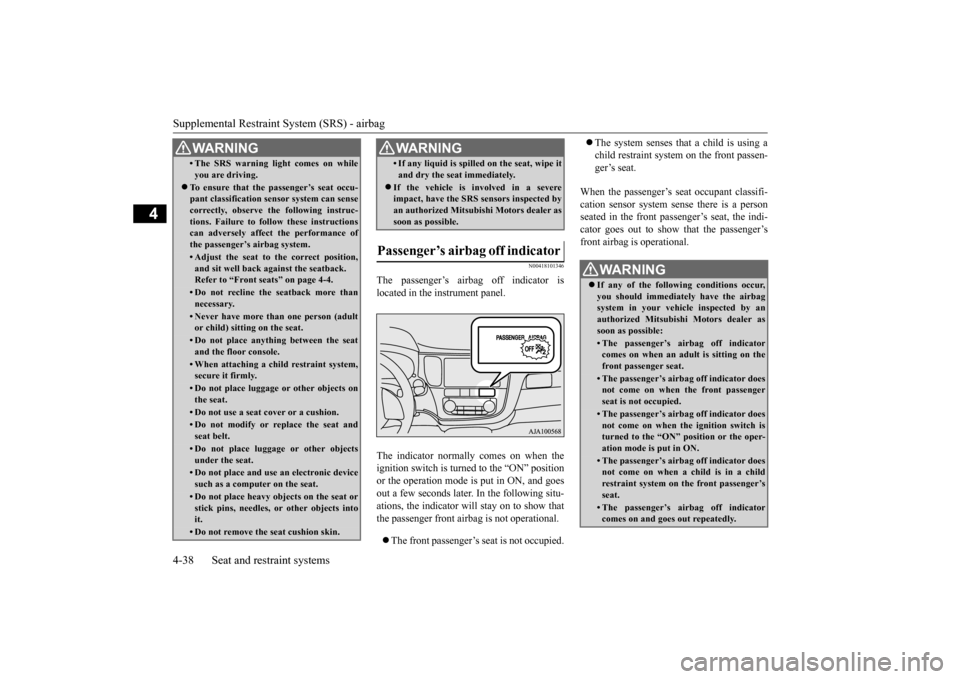
Supplemental Restraint System (SRS) - airbag 4-38 Seat and restraint systems
4
N00418101346
The passenger’s airbag off indicator is located in the instrument panel. The indicator normall
y comes on when the
ignition switch is turned to the “ON” position or the operation mode is put in ON, and goes out a few seconds later. In the following situ-ations, the indicator will stay on to show that the passenger front airb
ag is not operational.
The front passenger’s seat is not occupied.
The system senses that a child is using a child restraint system on the front passen-ger’s seat.
When the passenger’s seat occupant classifi- cation sensor sy
stem sense there is a person
seated in the front passenger’s seat, the indi-cator goes out to show that the passenger’s front airbag is operational.
• The SRS warning li
ght comes on while
you are driving.
To ensure that the passenger’s seat occu- pant classification sensor system can sense correctly, observe the following instruc-tions. Failure to follow these instructions can adversely affect
the performance of
the passenger’s airbag system.• Adjust the seat to the correct position,and sit well back
against the seatback.
Refer to “Front seats” on page 4-4.• Do not recline the seatback more thannecessary.• Never have more than one person (adultor child) sitting
on the seat.
• Do not place anything between the seat and the floor console.• When attaching a chil
d restraint system,
secure it firmly.• Do not place luggage or other objects onthe seat.• Do not use a seat cover or a cushion.• Do not modify or replace the seat andseat belt.• Do not place luggage or other objectsunder the seat.• Do not place and use
an electronic device
such as a computer on the seat.• Do not place heavy objects on the seat orstick pins, needles, or other objects intoit.• Do not remove the seat cushion skin.WA R N I N G
• If any liquid is spille
d on the seat, wipe it
and dry the seat immediately.
If the vehicle is involved in a severe impact, have the SRS sensors inspected by an authorized
Mitsubishi Motors dealer as
soon as possible.
Passenger’s airbag off indicator
WA R N I N G
WA R N I N G If any of the follow
ing conditions occur,
you should immediat
ely have the airbag
system in your vehicle inspected by anauthorized Mitsubishi
Motors dealer as
soon as possible:• The passenger’s airbag off indicatorcomes on when an adul
t is sitting on the
front passenger seat.• The passenger’s airb
ag off indicator does
not come on when the front passengerseat is not occupied.• The passenger’s airb
ag off indicator does
not come on when the ignition switch is turned to the “ON” position or the oper- ation mode is put in ON.• The passenger’s airb
ag off indicator does
not come on when a child is in a childrestraint system on the front passenger’s seat.• The passenger’s airbag off indicatorcomes on and goes out repeatedly.
BK0211800US.book 38 ページ 2014年3月12日 水曜日 午後2時42分
Page 66 of 446
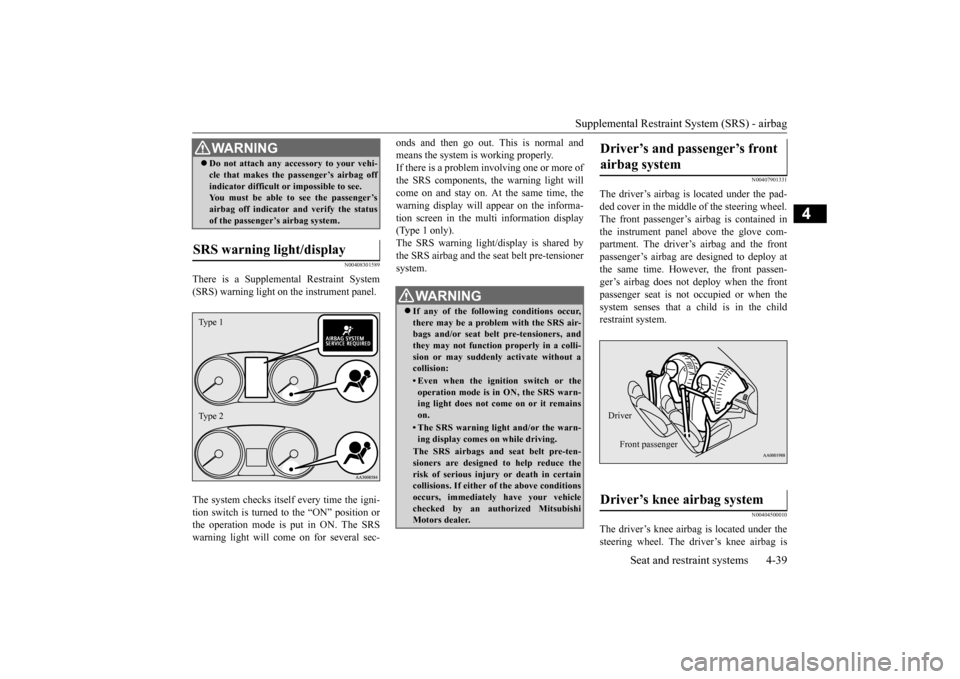
Supplemental Restraint System (SRS) - airbag
Seat and restraint systems 4-39
4
N00408301589
There is a Supplemental Restraint System (SRS) warning light on
the instrument panel.
The system checks itself every time the igni- tion switch is turned
to the “ON” position or
the operation mode is put in ON. The SRS warning light will co
me on for several sec-
onds and then go out. This is normal and means the system is working properly.If there is a problem involving one or more of the SRS components, the warning light will come on and stay on. At the same time, thewarning display will
appear on the informa-
tion screen in the multi information display (Type 1 only).The SRS warning light/display is shared by the SRS airbag and the seat belt pre-tensioner system.
N00407901331
The driver’s airbag is located under the pad-ded cover in the middle of the steering wheel.The front passenger’s airbag is contained in the instrument panel above the glove com- partment. The driver’s airbag and the frontpassenger’s airbag ar
e designed to deploy at
the same time. However, the front passen- ger’s airbag does not deploy when the front passenger seat is not
occupied or when the
system senses that a child is in the childrestraint system.
N00404500010
The driver’s knee airbag is located under the steering wheel. The driver’s knee airbag is
Do not attach any ac
cessory to your vehi-
cle that makes the passenger’s airbag offindicator difficult or impossible to see.You must be able to see the passenger’s airbag off indicator and verify the status of the passenger’s airbag system.
SRS warning light/display
WA R N I N G
Type 1 Type 2
WA R N I N G If any of the follow
ing conditions occur,
there may be a proble
m with the SRS air-
bags and/or seat belt pre-tensioners, and they may not function properly in a colli-sion or may suddenly
activate without a
collision:• Even when the ignition switch or theoperation mode is in ON, the SRS warn- ing light does not come on or it remainson.• The SRS warning light and/or the warn-ing display comes on while driving.The SRS airbags and seat belt pre-ten-sioners are designed to help reduce the risk of serious injury
or death in certain
collisions. If either of the above conditionsoccurs, immediately
have your vehicle
checked by an authorized Mitsubishi Motors dealer.
Driver’s and passenger’s front airbag system Driver’s knee airbag system Driver
Front passenger
BK0211800US.book 39 ページ 2014年3月12日 水曜日 午後2時42分
Page 67 of 446
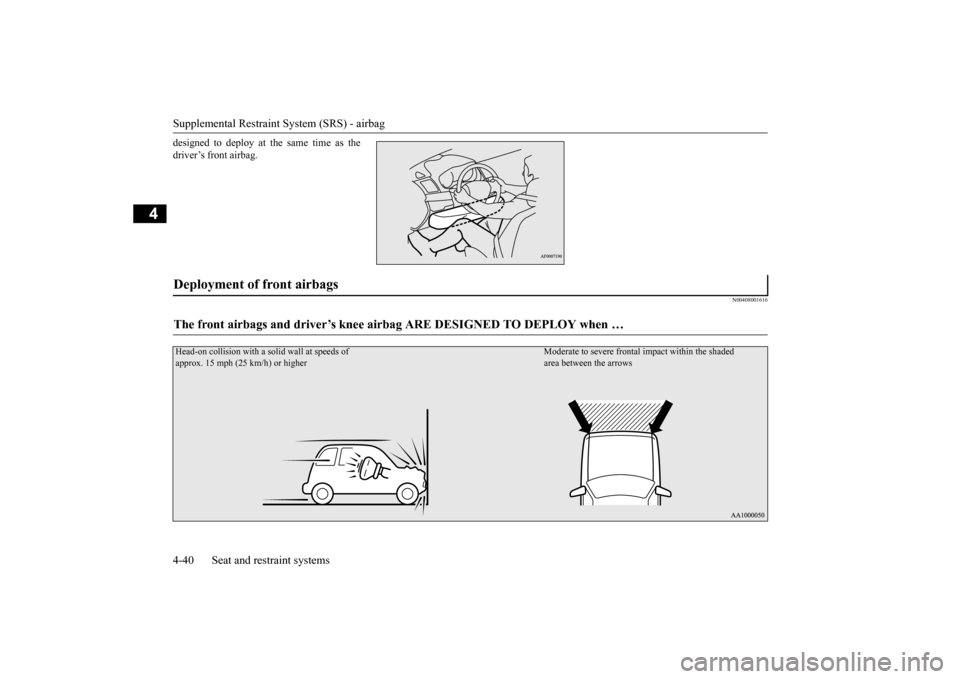
Supplemental Restraint System (SRS) - airbag 4-40 Seat and restraint systems
4
designed to deploy at
the same time as the
driver’s front airbag.
N00408001616
Deployment of front airbags The front airbags and driver’s knee airbag ARE DESIGNED TO DEPLOY when … Head-on collision with a solid wall at speeds of approx. 15 mph (25 km/h) or higher
Moderate to severe frontal
impact within the shaded
area between the arrows
BK0211800US.book 40 ページ 2014年3月12日 水曜日 午後2時42分
Page 68 of 446
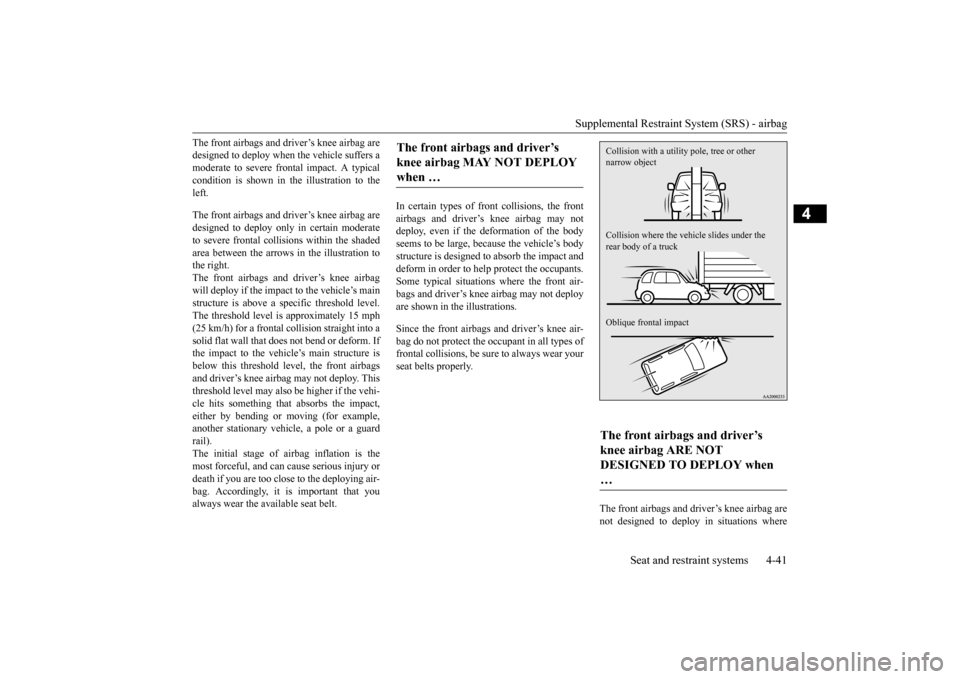
Supplemental Restraint System (SRS) - airbag
Seat and restraint systems 4-41
4
The front airbags and driver’s knee airbag are designed to deploy when
the vehicle suffers a
moderate to severe fro
ntal impact. A typical
condition is shown in th
e illustration to the
left. The front airbags and driver’s knee airbag are designed to deploy only in certain moderate to severe frontal collisions within the shaded area between the arrows in the illustration tothe right. The front airbags and driver’s knee airbag will deploy if the impact to the vehicle’s main structure is above a specific threshold level. The threshold level is approximately 15 mph(25 km/h) for a frontal collision straight into a solid flat wall that does
not bend or deform. If
the impact to the vehicle’s main structure isbelow this threshold level, the front airbags and driver’s knee airbag may not deploy. This threshold level may also
be higher if the vehi-
cle hits something that absorbs the impact, either by bending or moving (for example, another stationary vehi
cle, a pole or a guard
rail). The initial stage of airbag inflation is the most forceful, and can
cause serious injury or
death if you are too clos
e to the deploying air-
bag. Accordingly, it
is important that you
always wear the available seat belt.
In certain types of fr
ont collisions, the front
airbags and driver’s knee airbag may notdeploy, even if the deformation of the body seems to be large, be
cause the vehicle’s body
structure is designed to absorb the impact anddeform in order to help
protect the occupants.
Some typical situations where the front air- bags and driver’s knee airbag may not deploy are shown in the illustrations. Since the front airbags and driver’s knee air- bag do not protect the occupant in all types offrontal collisions, be su
re to always wear your
seat belts properly.
The front airbags and driver’s knee airbag are not designed to deploy in situations where
The front airbags and driver’s knee airbag MAY NOT DEPLOY when …
The front airbags and driver’s knee airbag ARE NOT DESIGNED TO DEPLOY when … Collision with a utility pole, tree or other narrow object Collision where the vehi
cle slides under the
rear body of a truck Oblique frontal impact
BK0211800US.book 41 ページ 2014年3月12日 水曜日 午後2時42分
Page 69 of 446
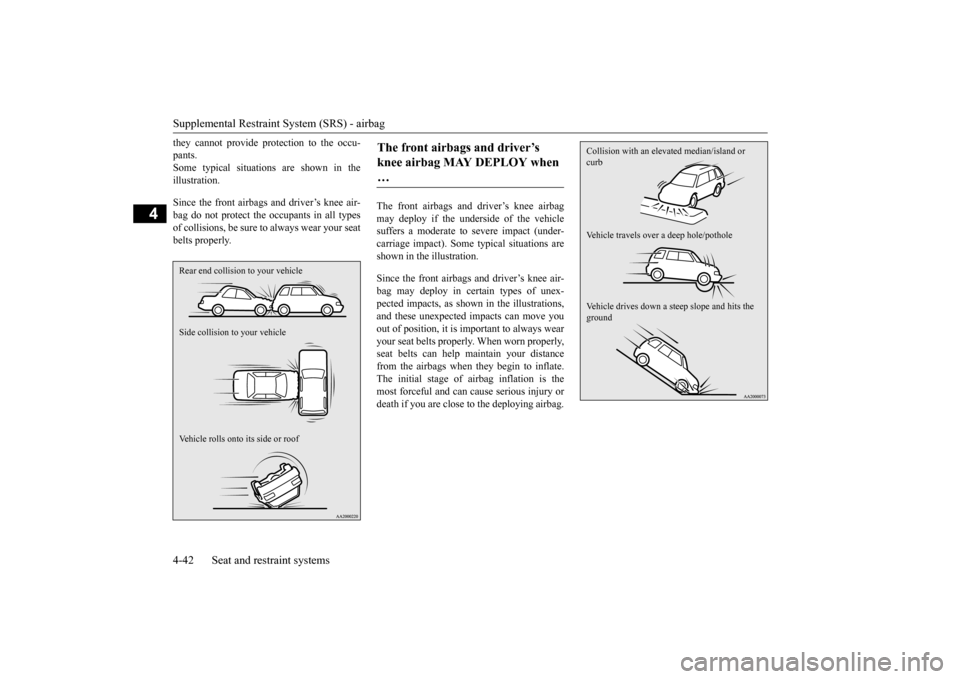
Supplemental Restraint System (SRS) - airbag 4-42 Seat and restraint systems
4
they cannot provide pr
otection to the occu-
pants.Some typical situations are shown in the illustration. Since the front airbags and driver’s knee air- bag do not protect the oc
cupants in all types
of collisions, be sure
to always wear your seat
belts properly.
The front airbags and driver’s knee airbag may deploy if the underside of the vehiclesuffers a moderate to severe impact (under- carriage impact). Some typical situations are shown in the illustration. Since the front airbags and driver’s knee air- bag may deploy in ce
rtain types of unex-
pected impacts, as show
n in the illustrations,
and these unexpected impacts can move you out of position, it is
important to always wear
your seat belts properly. When worn properly,seat belts can help maintain your distance from the airbags when they begin to inflate. The initial stage of airbag inflation is themost forceful and can cause serious injury or death if you are close to the deploying airbag.
Rear end collision to your vehicle Side collision to your vehicle Vehicle rolls onto its side or roof
The front airbags and driver’s knee airbag MAY DEPLOY when …
Collision with an elevat
ed median/island or
curb Vehicle travels over a deep hole/pothole Vehicle drives down a steep slope and hits the ground
BK0211800US.book 42 ページ 2014年3月12日 水曜日 午後2時42分
Page 70 of 446
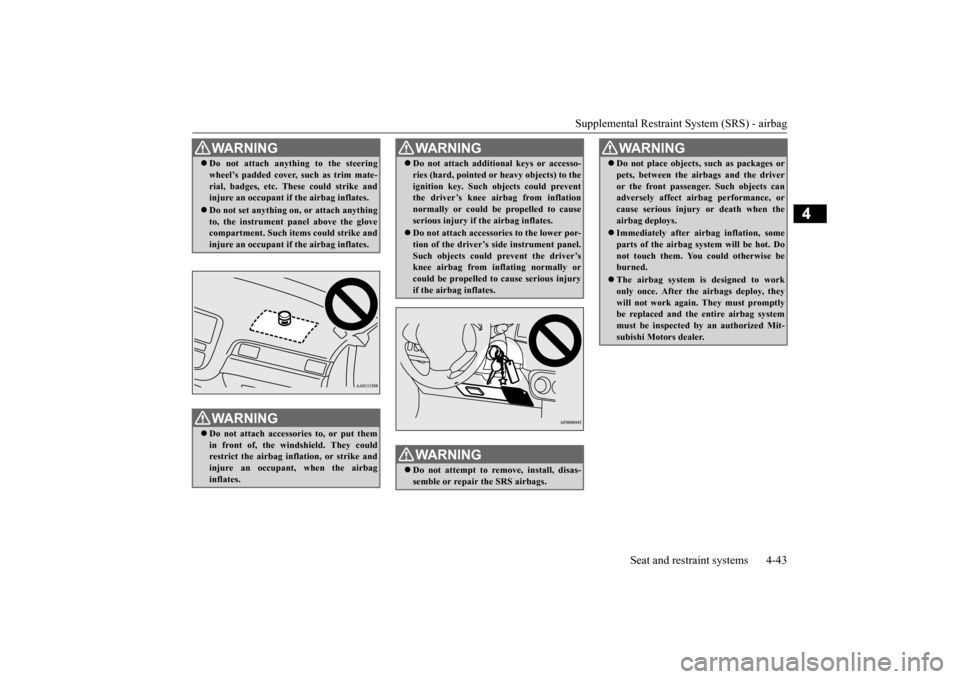
Supplemental Restraint System (SRS) - airbag
Seat and restraint systems 4-43
4
WA R N I N G Do not attach anything to the steering wheel’s padded cover, such as trim mate-rial, badges, etc. These could strike andinjure an occupant if
the airbag inflates.
Do not set anything on, or attach anything to, the instrument
panel above the glove
compartment. Such items could strike and injure an occupant if
the airbag inflates.
WA R N I N GDo not attach accessories to, or put them in front of, the wind
shield. They could
restrict the airbag infl
ation, or strike and
injure an occupant, when the airbag inflates.
Do not attach addition
al keys or accesso-
ries (hard, pointed or
heavy objects) to the
ignition key. Such objects could preventthe driver’s knee ai
rbag from inflation
normally or could be propelled to cause serious injury if
the airbag inflates.
Do not attach accessories to the lower por- tion of the driver’s side instrument panel.Such objects could prevent the driver’s knee airbag from inflating normally or could be propelled to cause serious injuryif the airbag inflates.WA R N I N G Do not attempt to remove, install, disas- semble or repair the SRS airbags.WA R N I N G
Do not place objects,
such as packages or
pets, between the airbags and the driveror the front passenger. Such objects canadversely affect ai
rbag performance, or
cause serious injury or death when the airbag deploys. Immediately after airbag inflation, some parts of the airbag syst
em will be hot. Do
not touch them. You could otherwise be burned. The airbag system is designed to work only once. After the
airbags deploy, they
will not work again. They must promptlybe replaced and the entire airbag system must be inspected by
an authorized Mit-
subishi Motors dealer.WA R N I N G
BK0211800US.book 43 ページ 2014年3月12日 水曜日 午後2時42分